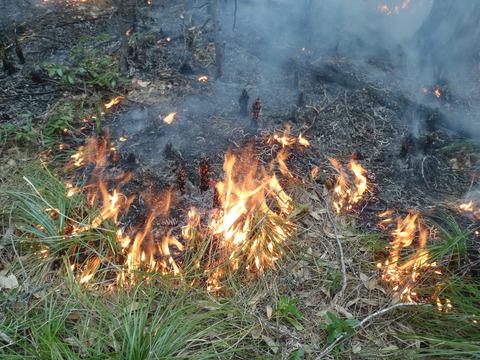Our official English website, www.x-mol.net, welcomes your feedback! (Note: you will need to create a separate account there.)
Simulated Indigenous fire stewardship increases the population growth rate of an understorey herb
Journal of Ecology ( IF 5.5 ) Pub Date : 2020-11-01 , DOI: 10.1111/1365-2745.13542 G. M. Hart‐Fredeluces 1, 2 , Tamara Ticktin 1 , Frank K. Lake 3
中文翻译:

模拟的土著消防管理提高了地下草本植物的种群增长率
更新日期:2020-11-01
Journal of Ecology ( IF 5.5 ) Pub Date : 2020-11-01 , DOI: 10.1111/1365-2745.13542 G. M. Hart‐Fredeluces 1, 2 , Tamara Ticktin 1 , Frank K. Lake 3
Affiliation

|
- Understanding how plant populations respond to multiple drivers is increasingly critical for biodiversity conservation under global change. Indigenous knowledge can provide guidance for sustainable management, but the outcome of its application in novel ecosystems is rarely known. Simulating the re‐introduction of Indigenous stewardship in contemporary contexts with population models allows for the comparison of different management scenarios and the elucidation of the mechanisms driving population outcomes.
- Beargrass Xerophyllum tenax is an ecologically and culturally important understorey plant managed through fire and leaf harvest by Native Americans. We collected demographic and abiotic data on beargrass over 3 years across fire severities in nine populations and conducted an experiment to simulate Native American leaf gathering. These data were used to build integral projections models (IPMs) with soil moisture and light availability as covariates. With these IPMs, we simulated stochastic population growth rates across future fire and leaf harvest scenarios. We then decomposed our simulation results using stochastic life table response experiments (SLTREs).
- The ‘no fire’ and ‘business as usual’ (180‐year fire return interval, 58% probability of high‐severity fire) scenarios resulted in lower population growth rates than ‘Indigenous fire stewardship’ (10‐year fire return interval, 10% chance of high‐severity fire). SLTREs revealed that Indigenous stewardship led to higher beargrass population growth rates due to greater fire frequency, higher adult survival and increased vegetative reproduction. Fire also interacted with harvest in the simulations; leaf harvest increased population growth rate only in combination with Indigenous fire stewardship.
- Synthesis. Stochastic and retrospective population dynamics tools combined with an understanding of Indigenous management practices allow for the comparison of future socio‐ecological scenarios as well as mechanistic understanding of differences between scenarios. Simulated Indigenous stewardship supported the long‐term persistence of X. tenax populations while business as usual and no fire did not. The benefits of Indigenous stewardship to population dynamics, and the complexity of interactive effects of multiple drivers, provide further impetus for collaboration across Indigenous and western knowledge systems. Xerophyllum tenax is presented as a model system to explore the influence of Indigenous stewardship, or its absence, on population dynamics.
中文翻译:

模拟的土著消防管理提高了地下草本植物的种群增长率
- 对于全球变化下的生物多样性保护而言,了解植物种群如何响应多种驱动因素变得越来越重要。土著知识可以为可持续管理提供指导,但其在新型生态系统中的应用成果却鲜为人知。通过人口模型模拟当代环境下的土著管理权的重新引入,可以比较不同的管理方案并阐明推动人口结果的机制。
- Beargrass Xerophyllum tenax是一种在生态和文化上很重要的下层植物,通过美洲原住民的火和叶收获来管理。我们在3年中收集了9个种群中火势严重的熊草的人口统计数据和非生物数据,并进行了模拟美国原住民叶收集的实验。这些数据被用来建立整体投影模型(IPM),其中土壤水分和光的有效性为协变量。通过这些IPM,我们模拟了未来火灾和烟叶收获情景下的随机种群增长率。然后,我们使用随机寿命表响应实验(SLTRE)分解仿真结果。
- “没有火灾”和“照常营业”(180年火灾恢复间隔,发生高烈度火灾的可能性为58%)场景导致的人口增长率低于“本地火灾管理”(10年火灾恢复间隔,10发生高强度火的几率)。SLTREs揭示,由于更高的射击频率,更高的成活率和增加的植物繁殖,土著管理导致更高的熊草种群增长率。在模拟中,火也与收获互动。叶采伐仅结合土著消防管理才能提高人口增长率。
- 综合。随机和回顾性的人口动态工具与对土著管理实践的理解相结合,可以比较未来的社会生态情景以及对情景之间差异的机械理解。模拟的原住民管理支持X. tenax种群的长期持久性,而照常营业,没有火灾。土著管理对人口动态的好处,以及多种驱动因素相互作用的复杂性,为跨土著和西方知识系统的合作提供了进一步的动力。Xerophyllum tenax是作为模型系统提出的,目的是探讨土著管理权或不存在管理权对人口动态的影响。


























 京公网安备 11010802027423号
京公网安备 11010802027423号